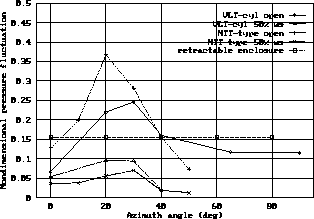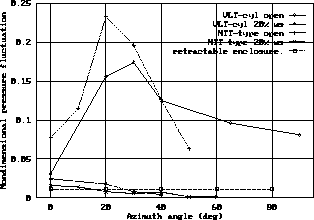



Next: Wind buffeting on
Up: Engineering criteria and
Previous: Engineering criteria and
Fig. 6.1 shows a comparison of the amplitude of
of rms
pressure fluctuations  acting on the upper part of an
8-meter telescope in various enclosure configurations.
The additional turbulence created by the slit is significant only
for azimuth angles < 40
acting on the upper part of an
8-meter telescope in various enclosure configurations.
The additional turbulence created by the slit is significant only
for azimuth angles < 40 . In principle,
the presence of a 50%
permeability windscreen across the slit can provide conditions
on the telescope in which the overall rms
amplitude
of pressure fluctuations is below the typical free flow situation.
. In principle,
the presence of a 50%
permeability windscreen across the slit can provide conditions
on the telescope in which the overall rms
amplitude
of pressure fluctuations is below the typical free flow situation.

Figure 6.1: Comparison of the amplitude of normalized rms
pressure
fluctuations  acting on
the telescope top ring in different enclosure configurations.
acting on
the telescope top ring in different enclosure configurations.
The advantage of the open air enclosure is more evident if one
compares the amplitude of pressure fluctuations with frequency
larger than 1 Hz, which
is a typical bandwidth of the closed loop control system of the
telescope drives (fig. 6.2).
The free flow wind contains very little turbulent
energy at high frequencies, while a slit produces most of the flow
turbulence right in that frequency range: only a 20%
permeability wind screen can reduce the pressure fluctuations to the
free flow level, by dramatically cutting
the mean flow speed.

Figure 6.2: Amplitude of rms
pressure fluctuations
with frequency > 1 Hz, acting on
the telescope top ring in different enclosures.




Next: Wind buffeting on
Up: Engineering criteria and
Previous: Engineering criteria and
Lorenzo Zago, lorenzo.zago@heig-vd.ch,
Mon Nov 6 23:33:14 GMT+0100 1995
 acting on the upper part of an
8-meter telescope in various enclosure configurations.
The additional turbulence created by the slit is significant only
for azimuth angles < 40
acting on the upper part of an
8-meter telescope in various enclosure configurations.
The additional turbulence created by the slit is significant only
for azimuth angles < 40 . In principle,
the presence of a 50%
permeability windscreen across the slit can provide conditions
on the telescope in which the overall rms
amplitude
of pressure fluctuations is below the typical free flow situation.
. In principle,
the presence of a 50%
permeability windscreen across the slit can provide conditions
on the telescope in which the overall rms
amplitude
of pressure fluctuations is below the typical free flow situation.





 acting on
the telescope top ring in different enclosure configurations.
acting on
the telescope top ring in different enclosure configurations.